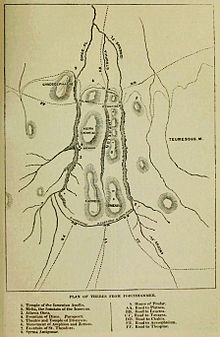Cadmea

The Cadmea, or Cadmeia (Greek: Καδμεία, Kadmía), was the citadel of ancient Thebes, Greece, which was named after Cadmus, the legendary founder of Thebes.[1] The area is thought to have been settled since at least the early Bronze Age, although the history of settlement can only be reliably dated from the late Mycenaean period (c. 1400 BC).
Classical period


In the classical and the early Hellenistic periods, the Cadmea served a similar purpose to the Acropolis of Athens; many public buildings were situated there, and the assemblies of Thebes and the Boeotian Confederacy are thought to have met there. During the Spartan (382–379/2 BC) and Macedonian occupations of Thebes, foreign garrisons were stationed on the Cadmea. Phoebidas was the Spartan general responsible for the unauthorized seizure of the citadel of Cadmea in 382 BC, in violation of the Peace of Antalcidas in place then.
The Sacred Band of Thebes was stationed in Cadmea as a standing force after it was recaptured from the Spartans in 379 BC, likely as defense against future attempts by foreign forces to take the citadel.[2][3][4]
Destruction and rebuilding
The Cadmea was destroyed in 335 BC by Alexander the Great, who razed the city of Thebes as a warning to other Greek cities contemplating revolt against his rule. Cassander, the Macedonian general who inherited the Greek territorial possessions of Alexander after his death, rebuilt the Cadmea in 316 BC.
Alternative meaning of cadmea
Cadmea is also an ancient name for calamine or zinc carbonate. Combined with copper, it was used in ancient times for the production of brass, as mentioned, for instance, by the Roman author, Pliny the Elder. The element, cadmium (Cd), was, in 1817, first isolated from an impurity in calamine; hence, the name, cadmium.
Excavation
The Cadmea was rediscovered by the Greek archaeologist Antonios Keramopoulos.[5]
References
- ^ Rockwell, Nicholas (2017-06-26). Thebes: A History. Taylor & Francis. p. 16. ISBN 978-1-317-21829-6.
- ^ Nicholas Ryan Rockwell (2008). The Boeotian Army: The Convergence of Warfare, Politics, Society, and Culture in the Classical Age of Greece. University of California. ISBN 978-1-109-02125-7.[permanent dead link]
- ^ Arthur Ferrill (1996). "Elite Forces in the Ancient World". In A. Hamish Ion; Keith Neilson (eds.). Elite Military Formations in War and Peace. Greenwood Publishing Group. pp. 38–41. ISBN 978-0-275-94640-1.
- ^ James R. Ashley (2004). The Macedonian Empire: The Era of Warfare Under Philip II and Alexander the Great, 359-323 B.C. McFarland. p. 434. ISBN 978-0-7864-1918-0.
- ^ Carpenter, Rhys (1935). "Letters of Cadmus". The American Journal of Philology. 56 (1): 5–13. doi:10.2307/289704. ISSN 0002-9475. JSTOR 289704.
